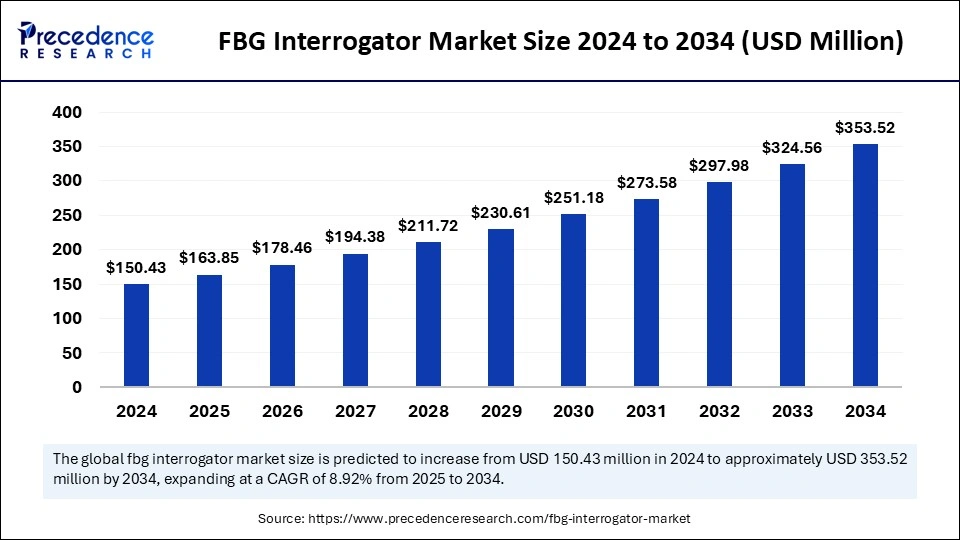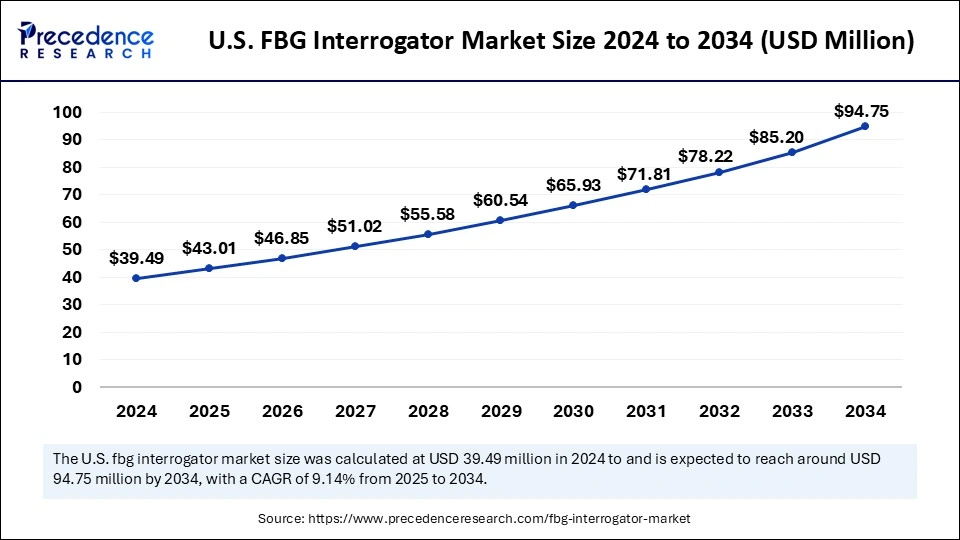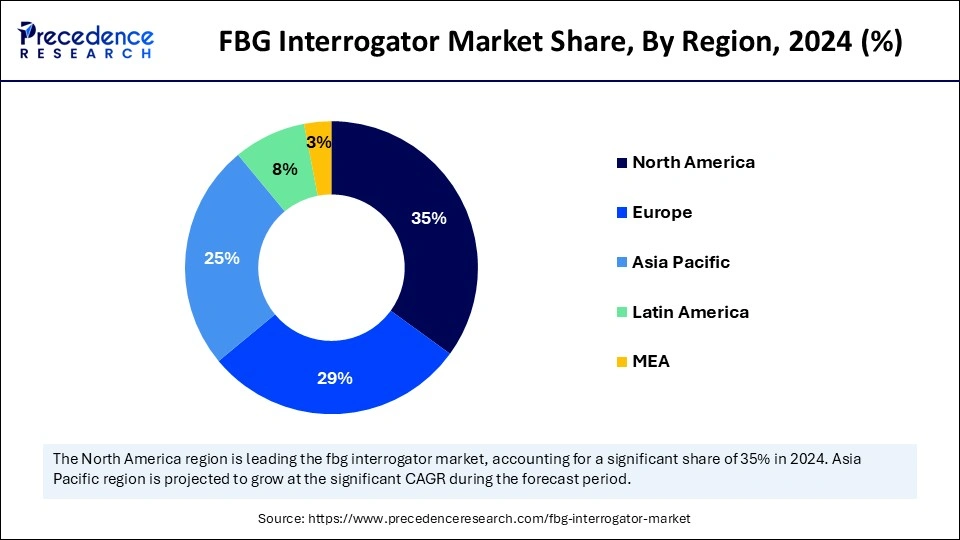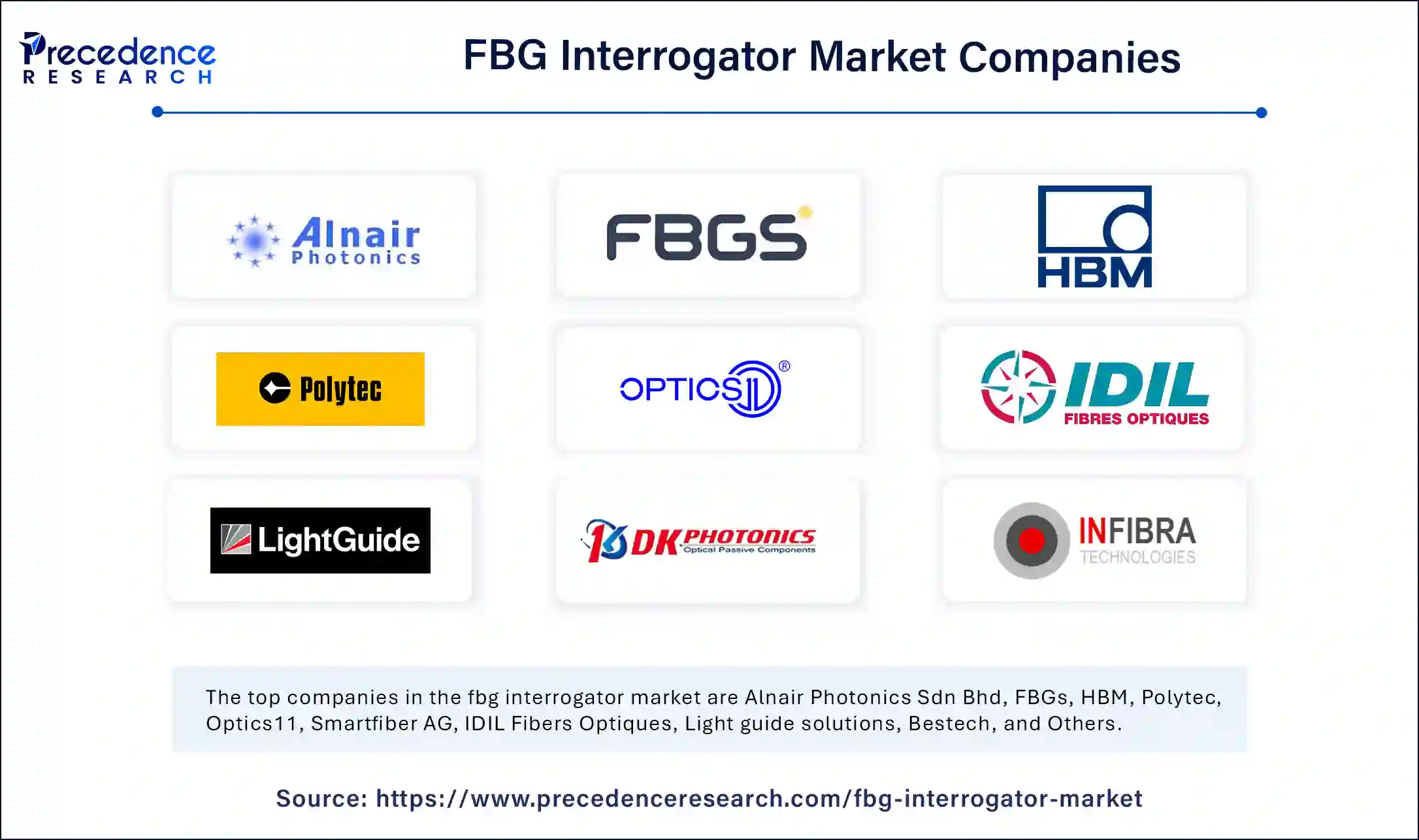The global FBG interrogator market size is calculated at USD 163.85 million in 2025 and is forecasted to reach around USD 353.52 million by 2034, accelerating at a CAGR of 8.92% from 2025 to 2034. The North America market size surpassed USD 52.65 million in 2024 and is expanding at a CAGR of 9.07% during the forecast period. The market sizing and forecasts are revenue-based (USD Million/Billion), with 2024 as the base year.
The global FBG interrogator market size accounted for USD 150.43 million in 2024 and is predicted to increase from USD 163.85 million in 2025 to approximately USD 353.52 million by 2034, expanding at a CAGR of 8.92% from 2025 to 2034. The growth of the market is driven by the increasing need for accurate, reliable, and real-time data acquisition in fields where precision is essential. The main advantage of FBG technology lies in its ability to simultaneously monitor various parameters, which has heightened its attractiveness to engineers and researchers. FBG interrogators are particularly well-suited for use in environments due to their resistance to electromagnetic interference.

Artificial Intelligence is significantly transforming the FBG interrogator market by improving real-time data analysis, predictive maintenance, automation, and precise monitoring across different industries. Machine learning algorithms powered by AI are being incorporated with FBG interrogators to handle large amounts of sensor data, facilitating quicker, more accurate, and actionable insights in sectors such as structural health monitoring, aerospace, defense, medical diagnostics, and energy infrastructure.
A major application of AI in FBG interrogators is in predictive maintenance and anomaly detection. Conventional monitoring systems depend on manual inspections and alarm systems based on thresholds, which can result in delayed responses in critical situations like bridges, railways, wind turbines, and pipelines. In contrast, AI-enabled FBG interrogators employ sophisticated pattern recognition and deep learning techniques to identify early indications of structural wear, pressure changes, or temperature shifts before they develop into significant failures. This proactive approach to maintenance minimizes downtime and prolongs the lifespan of infrastructure and industrial assets.
AI integration is improving precision sensing in the healthcare sector. FBG-based biomedical sensors facilitate minimally invasive diagnostics, patient monitoring, and robotic-assisted surgeries. AI-driven FBG interrogators assist in the real-time analysis of physiological data, enabling early disease detection, AI-supported decision-making, and tailored treatment plans. The capacity to process high-resolution sensor data using machine learning models allows healthcare providers to make quicker, more informed clinical decisions, enhancing patient outcomes and medical efficacy.
AI is also transforming real-time data processing and automation in the aerospace and defense industries. FBG sensors located in aircraft wings, spacecraft structures, and military vehicles produce a significant volume of strain, pressure, and temperature data. AI-enhanced FBG interrogators can swiftly analyze this information, offering automated flight adjustments, real-time structural health assessments, and improved safety protocols. This capability is especially advantageous for autonomous systems and Unmanned Aerial Vehicles, where AI-assisted FBG interrogation permits self-correcting mechanical adjustments without human involvement.
The U.S. FBG interrogator market size was exhibited at USD 39.49 million in 2024 and is projected to be worth around USD 94.75 million by 2034, growing at a CAGR of 9.14% from 2025 to 2034.

North America Market Trends
North America dominated the FBG interrogator market with the largest share, influenced by the widespread implementation of fiber optic sensing technologies across industrial automation, aerospace, energy infrastructure, and defense sectors. The region hosts prominent manufacturers, research institutions, and governmental organizations that are heavily investing in advanced sensing technologies for applications in structural health monitoring, predictive maintenance, and precise measurement. The significant demand for real-time monitoring solutions in sectors such as oil and gas, power transmission, and smart infrastructure has significantly accelerated the use of FBG interrogators in North America.
Regulatory frameworks and safety requirements imposed by organizations like NASA, the U.S. Department of Defense, and the Federal Aviation Administration have further promoted the use of FBG sensing systems in aircraft, military vehicles, and space exploration programs. Moreover, the emphasis on renewable energy and smart grid solutions in North America has led to the incorporation of FBG interrogators in wind turbines, solar power plants, and electrical distribution networks. The ongoing trend of Industry, along with AI-driven automation and IoT-enabled smart monitoring systems, has also reinforced the region's strong market position.

United States
In North America, the United States possesses the largest FBG interrogator market share, with prominent aerospace, defense, and industrial automation firms propelling the adoption of FBG interrogators. Significant investments in smart infrastructure projects, renewable energy oversight, and AI-integrated predictive maintenance systems within the country have heightened the demand for high-precision FBG sensing technologies. NASA, along with major defense contractors like Lockheed Martin and Boeing, is utilizing FBG interrogators for monitoring spacecraft structures, conducting aircraft health diagnostics, and implementing advanced military solutions.
The energy sector in the U.S. is progressively adopting FBG-based monitoring solutions for wind farms, power grid systems, and high-voltage transmission lines, facilitating grid stability and early fault detection. Supported by government initiatives promoting industrial automation and the development of smart cities, the U.S. continues to stand as a critical growth contributor in the FBG interrogator market.
Canada
Canada is experiencing an increase in the adoption of the FBG interrogator market within the sectors of infrastructure monitoring, renewable energy, and mining. The nation’s growing hydroelectric and wind energy endeavors necessitate real-time structural monitoring, which FBG sensors are vital for, as they help detect strain, temperature changes, and mechanical stress. Additionally, Canada’s commitment to monitoring the safety of railways and bridges has resulted in a greater integration of fiber optic sensing technology in large infrastructure initiatives.
Canada’s mining sector is adopting FBG-based solutions for safety to assess ground stability, tunnel integrity, and equipment conditions in underground operations. With government support for technological advancements and partnerships with academic institutions, Canada is establishing itself as an emerging market for the adoption of FBG interrogators across various industries.
Asia Pacific Market Trends
Asia Pacific is the fastest-growing market for the FBG interrogator market, with a significant CAGR during the forecast period, driven by swift industrialization, extensive infrastructure growth, and rising investments in smart sensing technologies. The booming telecommunications, transportation, and renewable energy industries in this region have increased demand for FBG-based monitoring systems, leading to fast-paced market development. Countries like China, Japan, South Korea, and India are leading the charge in adopting fiber optic sensing solutions for high-speed rail systems, earthquake detection, and aerospace use.
As governments invest in smart city projects, intelligent traffic management systems, and advanced manufacturing practices, FBG interrogators are being deployed more frequently for real-time monitoring and automation. Moreover, the region’s growing semiconductor and electronics manufacturing sector depends on FBG-based precision sensing for optimizing processes, monitoring temperatures, and executing high-precision measurements in chip fabrication. The integration of AI, IoT, and cloud-based analytics with fiber optic monitoring systems is further propelling the advancement of the market in the Asia Pacific.
China
China is a key player in the Asia Pacific FBG interrogator market, thanks to its extensive infrastructure initiatives, rapid urban development, and expansion of high-speed rail networks. The Chinese government has proactively utilized FBG sensing technology in bridges, tunnels, and subway systems to guarantee structural integrity and facilitate early fault detection. The expanding aerospace and defense industry within China is also incorporating FBG interrogators for monitoring aircraft and space vehicles, and the nation's renewable energy sector, especially in wind and solar power, is employing fiber optic sensors for effective energy management and fault identification.
Japan
Japan is utilizing FBG sensing technology in regions vulnerable to earthquakes, employing real-time seismic monitoring systems to detect ground shifts, structural strain, and possible failures in infrastructure such as buildings, dams, and railway systems. The nation’s bullet train network and aging infrastructure necessitate sophisticated monitoring solutions, leading to a rise in the use of FBG interrogators for ongoing safety evaluations. The electronics and semiconductor sectors in Japan also play a pivotal role, as precise optical sensing solutions are essential for chip production, cleanroom observation, and automation processes.
Europe Market Trends
Europe is considered to be a significantly growing area in the FBG interrogator market, fueled by stringent safety regulations, the growing adoption of Industry technologies, and an increasing need for monitoring renewable energy sources. The region’s strong focus on intelligent infrastructure, railway safety, and advancements in aerospace has led to the extensive deployment of FBG interrogators across multiple sectors.
Regulations from the European Union and national safety bodies require real-time monitoring solutions to be implemented in high-risk industries, further boosting the demand for fiber optic sensing technology. Europe’s dedication to achieving carbon neutrality and improving energy efficiency is also propelling the use of FBG interrogators in wind farms, hydroelectric facilities, and electrical transmission systems.
Germany
Germany stands out as a major market for FBG interrogators within Europe due to its sophisticated industrial foundation, robust research capabilities, and leadership in automation technologies. The nation is leading the charge in smart manufacturing and Industry initiatives, incorporating fiber optic sensing technology into automotive assembly lines, aerospace evaluations, and precision manufacturing applications.
Germany’s infrastructure development is also prioritizing real-time monitoring solutions for bridges, tunnels, and rail systems to ensure long-term structural integrity and predictive maintenance. Furthermore, the wind energy sector in the country is increasingly employing FBG interrogators for monitoring blade stress and optimizing turbine performance, aiding the transition toward sustainable energy sources.
United Kingdom
The United Kingdom is experiencing a rise in the use of FBG interrogators within the civil engineering, defense, and medical sectors. With an aging infrastructure and a focus on smart city initiatives, FBG-based monitoring solutions are being implemented to improve railway safety, bridge upkeep, and offshore wind farm effectiveness. FBG interrogators are being used in military aircraft, naval ships, and satellite systems for monitoring structural health. Additionally, the expanding application of fiber optic sensing in healthcare areas, such as robotic-assisted surgeries and patient surveillance systems.
Fiber Bragg grating technology, which is primarily utilized for sensing and monitoring various physical parameters such as strain, temperature, and pressure, is gaining increased traction for the FBG interrogator market. This market encompasses devices and systems that interpret data from FBG sensors to facilitate real-time monitoring across a wide range of applications, including aerospace, telecommunications, civil engineering, and industrial processes. The rising need for accurate, reliable, and real-time data collection in sectors where precision is vital has driven the widespread use of FBG interrogators.
FBG interrogators are particularly advantageous because they are resistant to electromagnetic interference, among other benefits. Their diverse applications include structural health monitoring in civil engineering, real-time tracking in oil and gas exploration, and even medical devices. As industries shift towards data-centric operations and heavily depend on continuous monitoring systems, the demand for advanced FBG interrogators is projected to grow. One of the main advantages of FBG technology is its ability to simultaneously monitor multiple parameters, which has made it increasingly attractive to engineers and researchers.
A notable trend in the FBG interrogator market is the increasing significance of optical sensors that enhance the functionality of FBG interrogators. Optical sensors, particularly for applications like temperature, pressure, and structural health monitoring, complement FBG systems to improve measurement accuracy and reliability. The collaboration between optical sensors and FBG interrogators enables industries to capture more robust data, which is crucial for upholding safety and performance standards. The combination of these technologies is expected to result in smarter, more efficient monitoring systems across various sectors.
| Report Coverage | Details |
| Market Size by 2034 | USD 353.52 Million |
| Market Size in 2025 | USD 163.85 Million |
| Market Size in 2024 | USD 150.43 Million |
| Market Growth Rate from 2025 to 2034 | CAGR of 8.92% |
| Dominated Region | North America |
| Fastest Growing Market | Asia Pacific |
| Base Year | 2024 |
| Forecast Period | 2025 to 2034 |
| Segments Covered | Type, Application, and Regions |
| Regions Covered | North America, Europe, Asia-Pacific, Latin America and Middle East & Africa |
Growing adoption of structural health monitoring systems
A significant factor driving the growth of the FBG interrogator market is the increasing desire for structural health monitoring systems in essential infrastructure, such as bridges, tunnels, railways, dams, and smart buildings. Governments and private entities globally are heavily investing in real-time structural monitoring technologies to improve safety, durability, and predictive maintenance for infrastructure projects. FBG interrogators are essential in SHM as they provide high-precision, real-time data on strain, stress, vibration, and temperature fluctuations.
In contrast to traditional electrical sensors, FBG-based monitoring systems are immune to electromagnetic interference, extremely durable, and capable of functioning in harsh environmental conditions. These benefits render them suitable for long-term use in critical structures, enabling the early detection of issues, lowering maintenance expenses, and enhancing disaster resilience. In areas susceptible to earthquakes, hurricanes, and severe weather events, governments are enforcing the implementation of real-time monitoring solutions to lessen infrastructure failures. This has resulted in a heightened adoption of FBG interrogators in large-scale civil engineering projects.
High upfront expenses and complicated setup procedure
Although there are benefits, a primary constraint that limits the extensive use of FBG interrogators is their substantial initial expenses and intricate installation needs. In comparison to conventional electronic sensors, FBG-based monitoring systems necessitate specialized fiber optic components, advanced interrogation units, and trained personnel for installation and calibration, resulting in elevated upfront costs. Implementing FBG sensors and interrogators in large-scale projects requires fiber optic cabling, accurate sensor positioning, and integration with data acquisition systems, which can be labor-intensive and technically demanding.
Industries operating under strict budget limitations, such as small manufacturing facilities and mid-sized infrastructure ventures, may be reluctant to adopt FBG interrogators due to financial worries. Moreover, retrofitting FBG sensor networks into existing systems can be logistically complicated, requiring alterations to current structures and advanced expertise for suitable calibration. These elements hinder the adoption rate, especially in developing regions where cost-effective alternatives like electrical strain gauges and piezoelectric sensors continue to prevail.
Rapid advancements and integration of newer technologies
The FBG interrogator market has experienced ongoing innovation, with key market players striving to create new, advanced interrogators that are not only more accurate but also more adaptable to specific industry needs. The trend of miniaturization and the development of portable, user-friendly systems have created new opportunities for the widespread use of these devices. As the demand for real-time, high-accuracy data continues to escalate, FBG interrogators are set to play a key role in various sectors, positioning them as a vital component of future monitoring technologies.
Fields such as wind energy, smart cities, and industrial automation are capitalizing on cloud-based monitoring systems, allowing FBG sensors to transmit real-time data to centralized control units. This capability enables operators to assess the health of infrastructure remotely, identify faults, and implement corrective measures without manual effort. The uptake of AI and IoT-enabled FBG interrogators is anticipated to promote substantial market expansion, particularly in smart infrastructure initiatives, autonomous industrial systems, and cutting-edge aerospace applications, creating new business opportunities for manufacturers and solution providers.
The 1×8 type segment dominated the FBG interrogator market with the largest market share, mainly due to its greater channel capacity, enhanced data acquisition capabilities, and extensive industrial use. The 1×8 type interrogators can simultaneously monitor up to eight fiber Bragg grating sensors, making them the favored option for large-scale industrial applications such as structural health monitoring, aerospace systems, energy infrastructure, and defense operations.
Industries that require real-time tracking of multiple parameters, including strain, temperature, and vibration, gain significant advantages from 1×8 FBG interrogators, as they offer improved data resolution and wider measurement coverage. These interrogators are commonly utilized in monitoring wind turbines, civil engineering projects (bridges, tunnels, and railways), and high-precision industrial automation systems, where numerous sensor points are essential for thorough data collection and predictive maintenance.
The 1×4 type segment will grow at a notable CAGR from 2025 to 2034 as various industries pursue economical, compact, and efficient fiber optic sensing solutions tailored for small to mid-scale uses. The 1×4 FBG interrogators can monitor as many as four FBG sensors at once, making them suitable for applications requiring fewer sensing points without compromising on precision and reliability. The rise of 1×4 interrogators is particularly driven by their growing usage in developing markets, where financial limitations and spatial constraints make them a cost-effective substitute for larger high-channel FBG systems.
1×4 FBG interrogators find extensive applications in biomedical sensing like patient monitoring and diagnostics for medical devices, industrial process control, and precision measurement, where accurate, real-time data and a compact design are crucial. Furthermore, innovations in miniaturized optical elements, wireless connectivity, and cloud-based data analytics have broadened the potential uses of 1×4 FBG interrogators, making them an appealing option for sectors aiming to adopt fiber optic sensing without incurring substantial infrastructure expenses.
The industrial segment dominated the FBG interrogator market with the largest share due to the increasing implementation of fiber optic sensing technologies across manufacturing, aerospace, defense, energy, and smart infrastructure sectors. Industries demand high-precision, real-time monitoring systems to maintain structural integrity, optimize processes, and enable predictive maintenance, establishing FBG interrogators as essential components in contemporary industrial automation.
There has been heightened demand for FBG interrogators in industrial scenarios such as machine condition monitoring, monitoring oil and gas pipelines, assessing power grid stability, and aerospace structural health monitoring due to their impressive sensitivity, durability, and capability to function efficiently in challenging conditions. In contrast to traditional electrical sensors, FBG-based interrogators offer improved immunity to electromagnetic interference, long-term stability, and the ability to simultaneously measure multiple parameters, making them the preferred solution for industrial applications.
The medical treatment segment will expand with a significant CAGR during the forecast period as fiber optic sensing technology continues to gain popularity in healthcare settings. The incorporation of FBG-based medical sensors within patient monitoring systems, minimally invasive surgical instruments, and wearable health devices is transforming medical diagnostics and treatment practices. There is a growing trend of using FBG interrogators for monitoring blood pressure, respiratory rates, body temperatures, and muscle strain, providing high accuracy and real-time data processing for improved patient care.
In robotic-assisted surgeries and smart prosthetics, FBG sensors deliver precise feedback on forces and movements, enhancing surgical accuracy and rehabilitation results. In addition, advancements in biocompatible fiber optics, AI-driven health monitoring, and remote patient diagnostics are fueling the uptake of FBG interrogators in the next generation of healthcare solutions. As personalized medicine, telemedicine, and AI-enhanced diagnostics proliferate, the medical treatment segment is anticipated to experience rapid growth, positioning FBG interrogators as a pivotal technology in the future of healthcare monitoring and precision medicine.

By Type
By Application
By Geography
For inquiries regarding discounts, bulk purchases, or customization requests, please contact us at sales@precedenceresearch.com
No cookie-cutter, only authentic analysis – take the 1st step to become a Precedence Research client